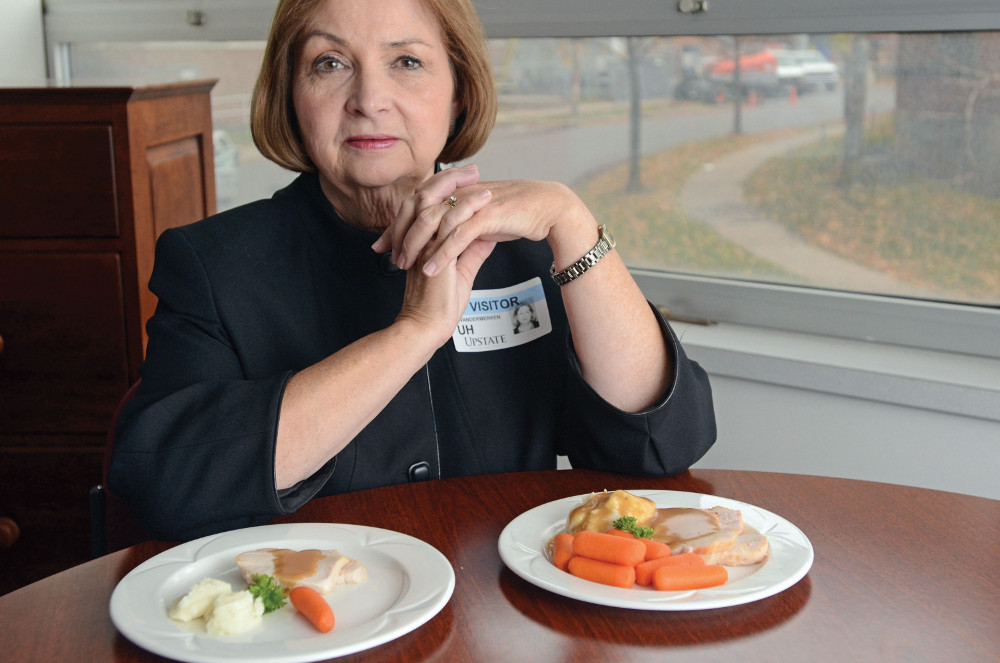COST AND BENEFITS OF SURGERY
After looking into various medical centers and attending informational sessions, Smith decided to have her surgery at Christiana Care Hospital in Wilmington, Delaware, in August 2009. She went through the hospital’s pre-surgical screening program, which entailed a number of medical tests and consultation with a team of doctors that included a cardiologist, a pulmonologist, a psychologist, a dietician, and other specialists to ensure that she was physically and mentally fit for the surgery. Often there are previously undiagnosed medical problems that must be considered or treated before a patient can undergo surgery.
After the surgery Smith lost weight, but it wasn’t a smooth ride. The stomach takes time to heal, and so doctors advise patients to ingest only liquids for the first few weeks, puréed foods for the next few weeks, and then gradually progress to solid foods. Because the stomach is made so small, it can carry only about an ounce of food at a time—a handful of crackers or a few broccoli florets. Eating too much at once can cause vomiting or intense stomach pain. But some people find it hard to control their eating habits and wind up suffering.
Moreover, patients must also stick to a special diet after the surgery or suffer other unpleasant consequences. Patients must introduce carbohydrates like breads and pasta into their diet very slowly, says Skarulis, of the National Institutes of Health. If they eat too many simple carbohydrates, the carbs enter the small intestine too quickly. This effect, called gastric dumping, causes nausea and massive diarrhea.
But the surgery does lead to weight loss. In 2007, Swedish researchers published results from a study in which they followed about 2,000 obese patients who had undergone weight-loss surgery—either gastric bypass or surgical banding—over 15 years and compared them to about 2,000 similarly obese people who didn’t have surgery but who were counseled in diet and exercise. After 10 years, those who had gastric bypass surgery weighed 25% less than their presurgery weight; those who had stomach-banding surgery were down about 15%. Those who got traditional diet advice lost no more than 2% of their weight. And research suggests that this weight loss, despite the nasty side effects, does more good than harm. There were 129 deaths in the diet-only group, mostly from weight-related heart disease and cancer, and 101 deaths in the surgery group—a large difference statistically. Deaths in the surgery group were also mainly from heart disease and cancer, although there were half the number of heart attack deaths in this group compared with the diet group (INFOGRAPHIC 26.8).
A multiyear study of obese people published in 2007 showed that those who underwent weight-loss surgery lost significantly more weight than those given only weight-loss counseling; there were also fewer deaths in the weight-loss group than in the counseling-only group.


Even more encouraging to scientists is the finding that both major types of weight-loss surgery can reverse type 2 diabetes, a condition in which the body can no longer regulate blood-sugar levels and that over time can damage organs and nerves (see Milestone 7). In 2004, a review in the Journal of the American Medical Association of 130 studies of more than 22,000 patients found that 77% of diabetics who have bariatric surgery are cured of diabetes and that 86% are either cured or have their symptoms improve. A 2012 study published in the New England Journal of Medicine showed that more than 75% of obese patients who had bariatric surgery achieved remission of their diabetes after 2 years compared to 0% of patients who had conventional medical therapy for diabetes.